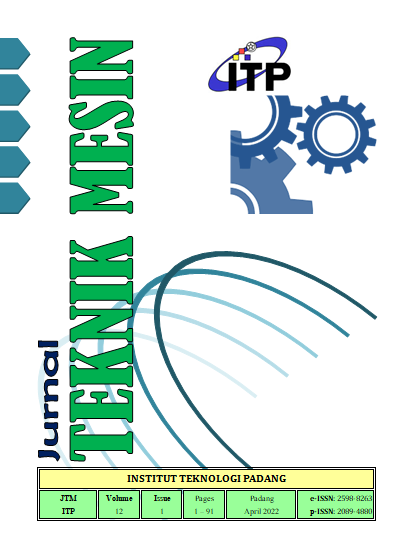Production Process of Steam Power Plant and Calculation of Thermal Efficiency: Case Study of Teluk Sirih Steam Power Plant
DOI:
https://doi.org/10.21063/jtm.2022.v12.i1.26-31Kata Kunci:
thermal, efficiency, turbine, steam, power plant, teluk sirih.Abstrak
The performance of a power plant can be known from the calculation of efficiency in the generating sector. Steam power plants utilize a series of energy conversion processes including: conversion of chemical energy into thermal energy when extracting heat from coal as fuel to heat boilers, conversion of thermal energy into mechanical energy in turbines and conversion of mechanical energy into electrical energy in generators. Like other steam power plants, the Teluk Sirih PLTU located in Bungus Teluk Kabung, West Sumatra has the same energy production process. it's just that the source of the water is taken from the sea so it requires special treatment to turn the water into water suitable for producing steam used in this power plant. The electricity production process will be explained in this study and an efficiency calculation process with a simple Rankine cycle is carried out to determine the efficiency of this power plant. From the calculation results, the thermal efficiency of PLTU Teluk Sirih is 29%. Based on the results of these calculations, it is known that the Telusk Sirih PLTU can be classified as a power plant with good efficiency.
Referensi
H. Y. Kurniawan, H. Gunawan, and B. Maluegha, “Kajian Efisiensi Termal Dari Boiler Di Pembangkit Listrik Tenaga Uap Amurang Unit 1,” J. Online Poros Tek. Mesin, vol. 4, p. 97, 2015.
Sartika and E. Wahyudi, “Distribusi Batubara dalam Memenuhi Kebutuhan Bahan Bakar PLTU Wilayah Kalimantan Barat,” Energi dan Kelistrikan J. Ilm., vol. 13, no. Juli-Desember, pp. 250–257, 2021.
O. W. Irawan, L. S. Pratama, and C. Insani, “Analisis Termodinamika Siklus Pembangkit Listrik Tenaga Uap Kapasitas 1500 kW,” JTM-ITI (Jurnal Tek. Mesin ITI), vol. 5, no. 3, p. 109, 2021, doi: 10.31543/jtm.v5i3.579.
V. Antono, W. Alfalah, and R. Windani, “Analisa Kegagalan Platen Tube Superheater Pltu Teluk Sirih,” Power Plant, vol. 6, no. 1, pp. 6–18, 2018, doi: 10.33322/powerplant.v6i1.67.
Sudirmanto and A. R. Effendi, “Analisis Perubahan Tekanan Vakum Kondensor Terhadap Kerja Turbin Dan Produksi Listrik PLTU Unit 1 Sebalang Menggunakan Simulasi Cycle Tempo,” J. Powerpl., vol. 8, no. 1, pp. 1–29, 2020.
N. Budianto, K. H. Kwee, and A. Hiendro, “Analisa Pengaruh Laju Kalor Terhadap Efisiensi Termal Pltu Sintang (3 X 7 Mw),” J. Tek. Elektro Univ. Tanjungpura, vol. Vol 2, no. 80, 2018.
E. R. EW, “Analisa Pengaruh Beban Listrik Terhadap Efesiensi Termal PLTU Payo Selincah Jambi,” J. Inov., vol. 2, no. 1, pp. 29–33, 2019, doi: 10.37338/ji.v2i1.37.
I. Febianto, M. I. Arsyad, and G. Suryani L, “STUDI EFISIENSI THERMAL BOILER MENGGUNAKAN DIRECT METHOD PADA PLTU SUNGAI RINGIN DI KABUPATEN SINTANG Indra Febianto 1) , M.,” J. Teknol. Rekayasa Tek. Mesin Jur. Tek. Mesin Fak. Tek. Univ. Tanjungpura Pontianak, vol. 1 (1), 2019.
A. D. Putra, I. Yusuf, and U. A. Gani, “Studi Potensi Limbah Biomassa Kelapa Sawit Sebagai Pembangkit Listrik Tenaga Uap (Pltu) Di Pt. Perkebunan Nusantara Xiii Pks Parindu,” Univ. Tanjungpura Pontianak, vol. 4, no. 2, pp. 1–8, 2016.
C. V. Cycle and T. Carnot, “Chapter 10 VAPOR AND COMBINED POWER CYCLES,” Analysis, no. c, pp. 1–29, 1934.
J. Ringler, M. Seifert, V. Guyotot, and W. Hübner, “Rankine cycle for waste heat recovery of IC engines,” SAE Tech. Pap., vol. 2, no. 1, pp. 67–76, 2009, doi: 10.4271/2009-01-0174.
Unduhan
Diterbitkan
Terbitan
Bagian
Lisensi
Hak Cipta (c) 2022 Putri Pratiwi, Zakil Hadi

Artikel ini berlisensiCreative Commons Attribution-NonCommercial-ShareAlike 4.0 International License.


